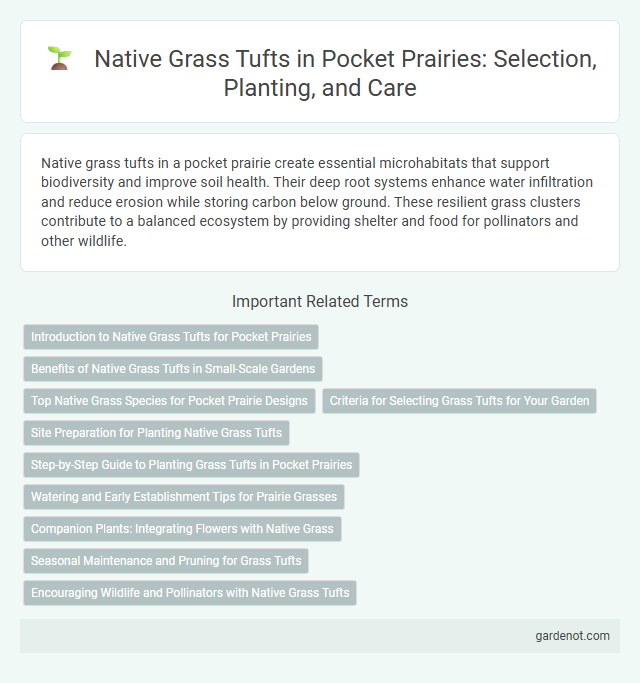Native grass tufts in a pocket prairie create essential microhabitats that support biodiversity and improve soil health. Their deep root systems enhance water infiltration and reduce erosion while storing carbon below ground. These resilient grass clusters contribute to a balanced ecosystem by providing shelter and food for pollinators and other wildlife.
Introduction to Native Grass Tufts for Pocket Prairies
Native grass tufts form the foundational structure of pocket prairies, supporting biodiversity and soil health by providing essential habitat and erosion control. Species such as Little Bluestem (Schizachyrium scoparium) and Indian Grass (Sorghastrum nutans) are well-suited for these compact ecosystems due to their deep root systems and drought resilience. Incorporating native grass tufts encourages pollinator activity and improves carbon sequestration, making them vital components of sustainable urban and rural pocket prairies.
Benefits of Native Grass Tufts in Small-Scale Gardens
Native grass tufts in small-scale gardens enhance soil health by preventing erosion and improving water retention through their deep root systems. These grasses support local biodiversity by providing habitat and food for native insects, birds, and pollinators. Their low maintenance requirements and adaptability to regional climate conditions make them an eco-friendly choice for sustainable garden design.
Top Native Grass Species for Pocket Prairie Designs
Top native grass species for pocket prairie designs include Little Bluestem (Schizachyrium scoparium), Switchgrass (Panicum virgatum), and Indian Grass (Sorghastrum nutans), known for their adaptability and ecological benefits. These grasses provide essential habitat for pollinators, improve soil health through deep root systems, and enhance aesthetic appeal with their varying textures and seasonal color changes. Incorporating these native grasses supports local biodiversity and promotes sustainable landscape practices.
Criteria for Selecting Grass Tufts for Your Garden
Choosing native grass tufts for your pocket prairie involves evaluating root depth, growth habit, and drought tolerance to ensure ecosystem compatibility and soil stabilization. Prioritize species like little bluestem (Schizachyrium scoparium) or switchgrass (Panicum virgatum) for their deep root systems and adaptability to local climate conditions. Selecting tufted grasses that support native pollinators and wildlife enhances biodiversity while requiring minimal maintenance.
Site Preparation for Planting Native Grass Tufts
Site preparation for planting native grass tufts in pocket prairies involves clearing existing vegetation and loosening the soil to promote root establishment. Removing invasive species and lightly tilling the soil enhances seedling growth by improving aeration and water infiltration. Proper grading ensures effective drainage, reducing waterlogging risks critical for native grass survival.
Step-by-Step Guide to Planting Grass Tufts in Pocket Prairies
Planting native grass tufts in pocket prairies begins with selecting region-specific species such as little bluestem, switchgrass, or Indian grass that thrive in local soil and climate conditions. Prepare the soil by removing weeds and loosening it to promote root penetration, then space tufts 12 to 18 inches apart to optimize growth and biodiversity. Water the tufts deeply after planting and maintain consistent moisture during the establishment period, ensuring healthy root development and resilience within the compact prairie ecosystem.
Watering and Early Establishment Tips for Prairie Grasses
Native grass tufts in pocket prairies require consistent moisture during early establishment to promote deep root growth and resilience. Watering should be moderate, ensuring the soil stays damp but not waterlogged, ideally providing one inch of water per week. Early watering supports seedling development and helps native grasses compete effectively against invasive species.
Companion Plants: Integrating Flowers with Native Grass
Native grass tufts provide a resilient foundation for pocket prairies by supporting diverse companion plants that enhance ecological balance. Integrating wildflowers such as coneflowers, black-eyed Susans, and butterfly milkweed with native grasses like little bluestem and switchgrass promotes pollinator habitats and soil health. This synergistic planting approach increases biodiversity while maintaining drought tolerance and requiring minimal maintenance.
Seasonal Maintenance and Pruning for Grass Tufts
Native grass tufts in pocket prairies require seasonal maintenance to promote healthy growth and prevent overcrowding. Pruning should be performed in late winter or early spring, cutting back dead foliage to about 3-6 inches above ground level, which encourages new shoots and maintains the plant's shape. Regular removal of accumulated debris and thinning dense clumps enhances air circulation and reduces the risk of disease.
Encouraging Wildlife and Pollinators with Native Grass Tufts
Native grass tufts play a crucial role in pocket prairies by providing essential habitats for wildlife and pollinators, fostering biodiversity and ecosystem health. These dense clumps offer shelter and nesting sites for insects, birds, and small mammals, while their flowers supply nectar and pollen to native pollinators like bees and butterflies. Incorporating native grass tufts enhances ecological balance, supports species conservation, and promotes natural pest control in prairie restoration projects.
Native grass tufts Infographic

 gardenot.com
gardenot.com